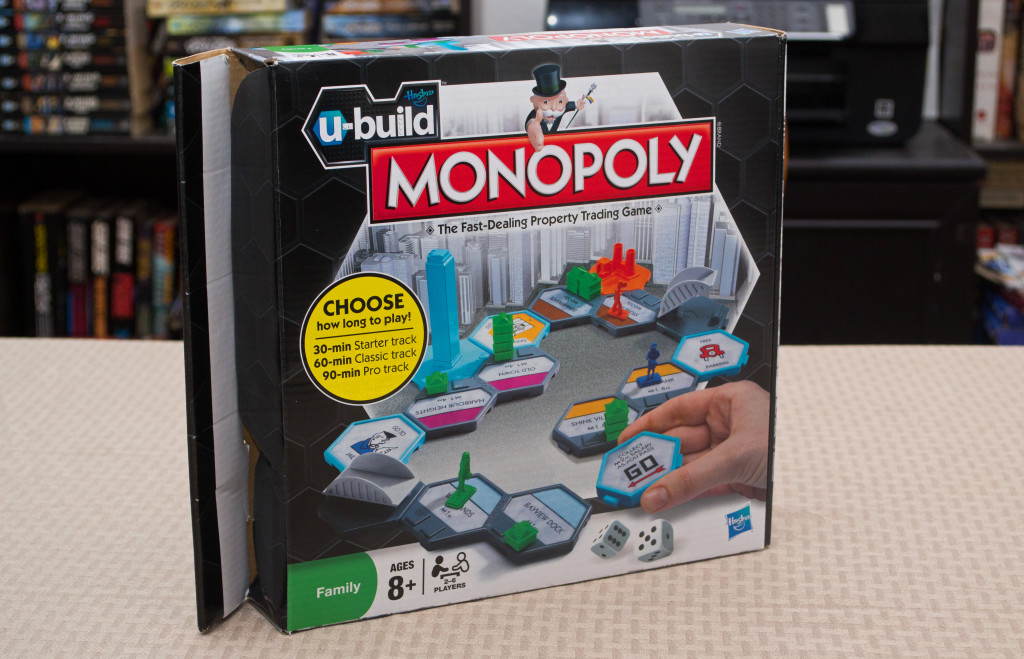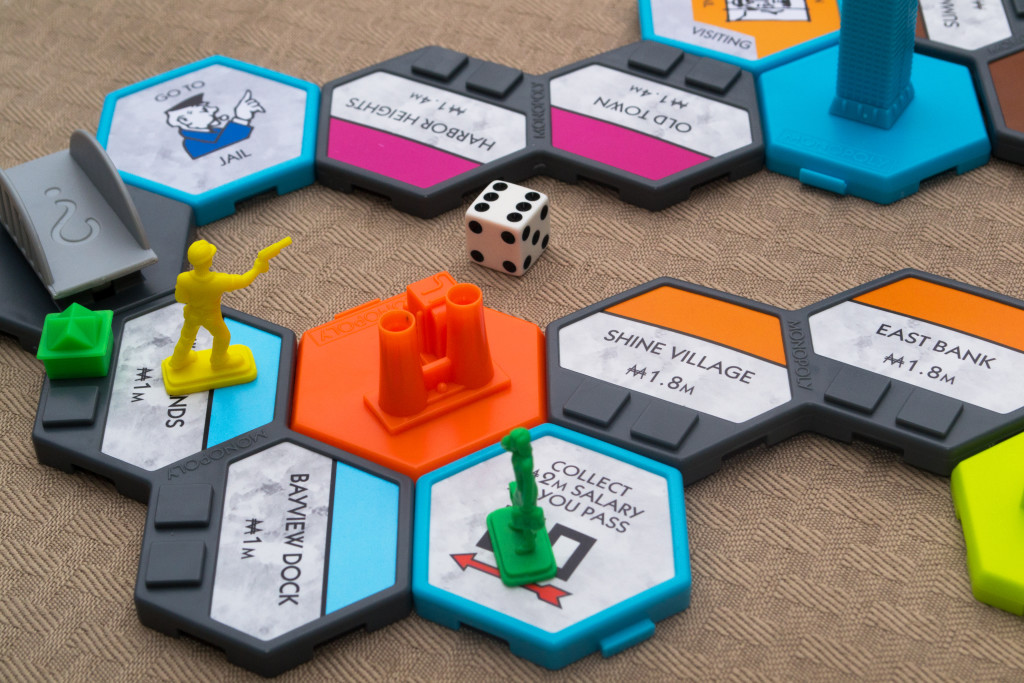I’m not even going to try to count the number of Monopoly variants out on the market. While I admit it would be really awesome to play on a “Mario” or “Zelda” themed board, most play roughly the same way. As such, I tend to see these things as cash-grabs, reserved mainly for loyal collectors who have OCD tendencies. While I tend to be a bit obsessive in my hobbies, “Monopoly” doesn’t rank high up on my “need to own” list. With that said, I’ve enjoyed playing “Monopoly: Electronic Banking Edition“, “Monopoly Deal“, “Monopoly Empire“, and “Monopoly Millionaire” because they break the mold and do something different. It was for this reason that I decided to give “U-Build Monopoly” a spin.
Components
12 Double District Tiles, 4 Single Tiles, 2 Railroad Tiles, 4 Bridges, 6 Movers, 91 Buildings, 22 District Cards, 17 Chance Cards, 4 Reminder Cards, 2 Dice, 1 Money Pack, and 1 Track Set-up Sheet.
Setup & Gameplay
“U-Build Monopoly” features three preset ways to set up your game, though players have the option of creating their own track. “Starter” takes about 30 minutes to play, “Classic” takes about 60 minutes to play, and “Pro” takes about 90 minutes to play. Depending on which option players choose, they’ll assemble the track by clicking the tiles together. The number of dice used, starting money received, and buildings reserved for the pool will also change depending on the chosen mode. All players choose a mover, begin on “GO”, and assign a banker. Highest roller gets to go first with turns proceeding clockwise.
On a player’s turn, they’ll:
1. Roll and move clockwise.
2. Resolve movement. This can involve buying unowned property (or starting an auction), paying rent to another player, building/moving a hazard (planning permission space), constructing a bonus building (planning permission space), opening/closing a bridge, and going to jail. The options available to you will change depending on where you land.
Other things to note:
- Passing Go grants you 2M.
- Rolling doubles (assuming you’re playing a mode that allows for two dice) allows you to go again, though three doubles in a row will send you to jail.
- While in jail you can collect rent and bid on auctions, but can’t build or move hazards.
- If you LAND on a bridge that is up, pay 1M to close it (put it down) and take a Chance. If it’s down, open it (raise it) and take a chance.
- If you PASS a bridge that is up, pay 1M to close it (put it down). If it’s down, you pass it for free.
- Planning permission spaces allow you to build a lime green bonus building next to a district you own OR build an orange hazard next to another player’s district OR move a hazard space by one.
- Constructing a lime green bonus building (wind farm, school, park) next to your districts will protect them from hazards.
- The stadium, a special building that is not considered a bonus building, can be built once you have two districts of the same color. You can then collect 3M when you pass GO instead of 2M, even when the property is mortgaged. It does not increase the rent value and will not protect the districts it touches from hazards.
- You cannot build a bonus building next to a district which has a hazard touching it, nor can you build or move a hazard next to a district that has a bonus building touching it.
- Railroad tiles serve to “connect” a custom track that doesn’t physically connect. You don’t count railroads as a space and you’ll instead skip over them.
- Once you own a district, you can place up to eight blocks on it (three per turn). You don’t need to own the set.
3. Build up to three residential/industrial blocks on a district you own (optional). Building prices are shown on the district cards. Residential zones and industrial zones both increase rent, though industrial zones are more expensive to build. Residential zones become worthless when next to a hazard though, meaning that they won’t boost rent for as long as the hazard is there. Industrial zones, on the other hand, are immune to hazards.
4. Move a hazard one or two spaces at 1M per space (optional).
The goal of the game is to be the richest player at the game’s end, which occurs when one player goes bankrupt. The richest player wins the game! It’s important to stress that the above rules may vary slightly, depending on which mode (starter, classic, pro) you’re playing. It’s also important to note that I did not cover all of the rules found in the manual, but should give you the general idea as to how the game is played.
The Review
“Monopoly” has a reputation of being pretty long-winded in that games never seem to end. Not the case with “U-Build Monopoly”, I’m happy to report. The starter track, while ignoring some of the rules/components listed above, can be played in about a half-hour. The industrial buildings and Monopoly tower, for example, are only used in the classic and pro tracks. By that same token, players are free to customize the board’s layout and include whatever buildings they want so as long as they understand that the game might be slightly unbalanced should they deviate too far from the norm.
The components themselves aren’t all that great as far as quality is concerned and the instruction manual is a bit “off” in a few places. For example, page 17 doesn’t list the stadium as a building you’ll need for the classic track, yet page 9 states that the stadium is used in classic and pro tracks. The rules can be a bit overwhelming to first time players, so I recommend starting with the starter track AND not worrying so much about getting the rules right. It’s not the end of the world if you miss something…after all, games exist to provide a form of entertainment. What’s important is that you and your group have fun…if that means house-ruling something that isn’t clear or doesn’t make sense, so be it. Be creative!
Overall, “U-Build Monopoly” is a fairly good value for its $5-10 price tag. The ability to customize your own tracks certainly adds to the replayability factor…the more you’re willing to think outside the box, the more you’ll get out of this product. I wouldn’t have minded paying a few extra bucks so that the components could be of better quality, but they succeed at what they are designed to do. While there are plenty “Monopoly” variants of better quality out on the market, this one will provide you and your family/friends with something slightly different to play…great for when you’re tired of playing the same old rules over and over again. For example, I like the fact that the game minimizes the luck factor a bit in that hazards (and bonus buildings) can be used strategically. That’s something you can’t do in plain old “Monopoly”. What’s better, the game (compared to standard “Monopoly”) actually ends at some point!
In the end, “Monopoly U-Build” is filled with some great ideas, but falls short in the implementation due to subpar component quality. Even some of the bags that initially hold the components are not resealable, which is a poor design choice considering that the box barely has an insert. Make sure to have extra baggies handy for the smaller pieces. Then again, the game is only $5-10…had it been any higher, the review score would have plummeted accordingly.
Final Verdict: 7/10
—


